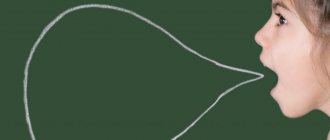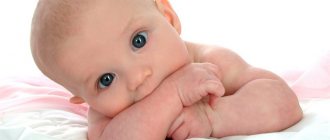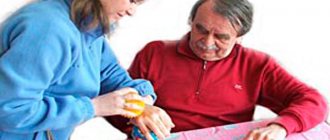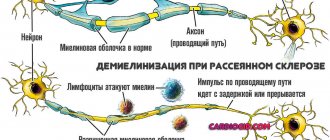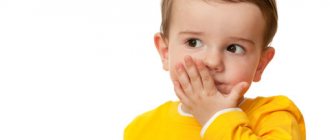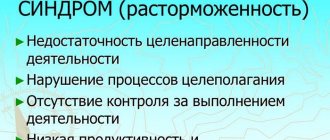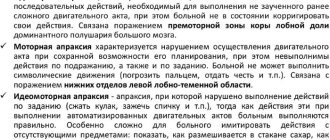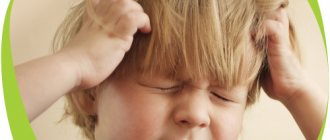Restless, interrupted sleep and snoring can be symptoms of a serious condition called sleep apnea.
The respiratory function is one of the most important in the body, and even such a short-term cessation of it sometimes leads to serious consequences.
Our article will tell you what sleep apnea syndrome is in children and adolescents and what the causes of the disease are.
Definition of disease
Temporary cessation of breathing - apnea - often occurs in children and adolescents.
But unlike infants, apnea in children after one year is not physiological, but indicates the presence of a number of health problems.
A typical picture of this disease is periodic, quite frequent (more than 5 times in one hour) stoppages of breathing, which always occur only during sleep.
Their duration is more than 10 seconds, and can reach 30-40 seconds . During the period when the lungs stop working, the child’s body does not receive the required amount of oxygen.
This leads to various dysfunctions of the nervous, vascular and other systems.
Prevention
To prevent attacks of sleep apnea or reduce their manifestations to a minimum, you can follow a number of simple steps:
- put the child to sleep in a position on his side;
- use an elastic mattress for sleeping;
- take the baby's pillow;
- ventilate the sleeping area;
- do not wrap the child up.
In addition, for healthy sleep, regular walks in the fresh air, adherence to a routine, and a calm, relaxing environment in the evenings are recommended.
To avoid the negative consequences caused by attacks of sleep apnea, it is necessary to accustom the child to a healthy lifestyle from an early age and monitor his general condition and behavior. You should periodically monitor him during sleep to make sure that the baby is sleeping calmly and soundly.
Reasons for the development of the syndrome in a child
There are two main reasons for the occurrence of sleep apnea in children:
- disruption of the respiratory center in the brain stem;
- blockage of the airways.
In the first case, apnea will be associated with diseases of the nervous system and heart, acting as one of their complications.
It can occur with epileptic changes in the central nervous system, after suffering a traumatic brain injury, due to taking medications, under the influence of bacteria or viruses, under the influence of changes in blood composition (decreased amount of sugar or hemoglobin), with excess body weight.
In the second, breathing stops due to narrowing of the airways , i.e. mechanical obstruction to air flow.
This effect occurs with excessive relaxation of the muscles that support the walls of the pharynx, proliferation of the tissue of the palatine tonsils, the appearance of polyps, the presence of congenital anomalies in the structure of the tongue and jaw apparatus, and spasms of the larynx.
The combination of causes leads to a complex syndrome, which is characterized by more severe breathing problems.
The most common type is the second, which is called obstructive.
What is apnea in a baby: reasons for holding and stopping breathing
Apnea is understood as an involuntary cessation of breathing associated with internal causes of the body.
The syndrome is characterized by dangerous symptoms and requires emergency care, since the disease most often occurs during sleep, when a person cannot control either himself or the processes of the respiratory system.
Apnea in newborns can occur in infancy, immediately after birth, and in some cases it also develops in the child years later.
Premature babies are more likely to have sleep apnea
What is apnea syndrome
What is apnea in newborns - cessation of breathing for more than 20 seconds, or for 10 seconds with concomitant bradycardia. This period of time is enough for the baby to experience hypoxia, which causes brain damage.
Apnea in infants born prematurely is the most common symptom, since their respiratory system and breathing control center are underdeveloped. The attacks begin to subside closer to 40-45 weeks of the baby’s life, as his nervous system matures.
Important ! If the syndrome occurs, you should not diagnose and treat it at home. All necessary manipulations should be carried out by a specialist and the necessary measures should be prescribed for subsequent improvement of the condition.
Children older than one year experience sleep apnea due to airway obstruction: this is either a pathology or a congenital disorder. Here it is necessary to monitor and eliminate probable causes.
At risk are infants with birth injuries, those born prematurely, and those with disorders of the central nervous system.
Kinds
Normal respiratory rate in newborns
Intermittent breathing in a newborn is especially frightening for parents, since they may not even notice that the child is having an attack. Despite the fact that at first the mother wakes up several times during the night to feed the baby, she may not have time to provide first aid for apnea.
The following types are distinguished:
- Central. In this case, the activity of the main respiratory center is disrupted. At the time of the syndrome, the muscles do not receive an impulse that stimulates their motor activity. This type often occurs in children who have experienced birth trauma.
Baby birth trauma
- Obstructive. This type occurs when the respiratory tract is obstructed; air flows in unevenly, causing the baby’s chest to move in a manner characteristic of an attack. In children with cleft lip, apnea is most often of this type.
Cleft lip in a baby
- Mixed. It starts from the central one, then the attack becomes obstructive. This is one of the most difficult categories to diagnose and treat.
Note ! Obstructive seizures are most common in children aged 2-8 years.
Causes of pathology
Why does a newborn baby hold his breath during sleep?
Respiratory arrest in newborns occurs under various circumstances.
Causes of obstructive apnea in premature newborns:
- An abnormally enlarged tongue, or macroglossia.
- The laryngeal muscle contracts involuntarily - laryngospasm.
- The growth of cartilage and bones is slowed down – achondroplasia.
- Paralysis or injury to the posterior laryngeal muscle.
- Enlarged tonsils.
- Obesity of a child or adult.
- Congenital underdevelopment of the tongue.
Overweight baby
If this is a central view, then the reasons are as follows:
- Childbirth before term is prematurity.
- Injuries to the brain and spinal cord during childbirth.
- Low blood glucose levels.
- Disorders of gas exchange in the alveoli.
- Epilepsy.
- Infections of a viral or bacteriological nature.
- Anemia.
- Arrhythmia.
- Sepsis.
Neonatal sepsis
Additional Information. The diagnosis of breath holding in newborns of the idiopathic type is made very rarely, if the cause of the syndrome cannot be identified.
Causes of mixed apnea:
- Pathological heart diseases.
- Hypothermia or overheating of the body.
- Lack of calcium or glucose.
- Consequences of alcohol or drug use during pregnancy by the mother.
Symptoms
A child's eyes swell after sleep - possible causes, symptoms
What is a night apnea attack in infants is the body’s reaction against the background of general muscle relaxation. Usually the child wakes up immediately because he feels short-term hypoxia. He gets very scared, so adrenaline is released, this, in turn, negatively affects rest and the nervous system.
What are the characteristic symptoms:
- heavy snoring;
- there is no breathing for 10 seconds or more;
- the baby breathes through his mouth;
- profuse sweating;
Infant sweating during sleep
- restless sleep;
- headache during the day;
- reduced development dynamics.
As a result, the baby constantly lacks sleep, and moodiness and irritability develop. Subsequently, the child’s appetite, weight and activity decrease.
Note ! Breath-holding attacks often manifest themselves during the REM sleep phase, so they may go unnoticed. In this case, it is worth monitoring the child’s behavior during the day and snoring at night.
Complications of apnea:
- child hyperactivity and attention deficit;
- hypertensive crises;
- attacks of arrhythmia;
- pathologies of the heart, especially coronary disease and heart failure, which are accompanied by heart attack and stroke.
First aid for an apnea attack
If the syndrome continues for a long time, it can lead to asphyxia of the child, which threatens his life. In this situation, parents must act quickly and harmoniously.
An ambulance is urgently called if:
- the child’s legs and arms, nose and lips have turned blue (in medicine this characteristic is called cyanosis);
- pulse less than 90 beats per minute;
- limbs hang down involuntarily.
Cyanosis is evidence that the body does not have enough oxygen. First, you should try touching the child on the back with your finger, touching the earlobes, massaging the arms, legs, and chest. If all manipulations do not bring favorable results, then artificial respiration begins.
Step-by-step instruction:
- Place the child on a horizontal, flat surface.
- The airways are checked, if the tongue is sunken, then lift the chin and move the head back.
- The lips cover the nose and mouth.
- Inhale and make 2 smooth blows that last no more than 2 seconds.
- If there are no movements in the chest, then steps 2-4 are performed again, but it is worth changing the position of the head.
- If the chest moves and a pulse is felt, it means everything is being done correctly.
- If there is a pulse, then the manipulation continues.
If there is no pulse, then they begin to massage the heart. The index and middle fingers are placed on the middle of the chest, just below the nipple line, and sharp pressure is applied 5 times for 3 seconds. In this case, the chest should bend by 1.5-2 cm. Then alternate 1 blow-in - 5 presses.
Newborn heart massage
A set of measures is carried out until the ambulance arrives, after which the child must be hospitalized.
Prevention of breathing problems in children
First of all, the expectant mother should eliminate the use of drugs, alcohol and smoking tobacco products during pregnancy.
Use all medications only as prescribed by a doctor and in exceptional cases. The mother’s diet is also important: it should be balanced, with an abundance of vitamins and microelements.
Don’t forget about emotional health: avoid stress and nervous overload.
If a child is diagnosed with sleep apnea, you should:
- Control his weight;
- Promptly treat respiratory organs, endocrine and neurological disorders, allergic manifestations;
- 3 hours before bedtime, do not eat heavy food;
- Prepare an optimal place to sleep; the mattress should be semi-hard;
- The child sleeps on his side, try to support the head and spine as much as possible at the same level;
- Air humidity in the children's room is 50-60%;
- Create optimal conditions for physical activity with a predominance of aerobic exercise: cycling, sports games, swimming, walking a lot in the fresh air.
If apnea develops actively and the child does not receive the necessary treatment, there is a high risk of additional symptoms that lead to disability in adulthood.
With proper and timely treatment, apnea in an infant will begin to go away quite quickly, provided that all specialist recommendations and first aid are provided. The consequences of incorrect actions can lead to a threat to the baby’s life and death.
Source: https://kpoxa.info/zdorovie-pitanie/apnoe-u-novorozhdennykh.html
Symptoms in babies and teenagers
The development of this pathology is accompanied by a stable set of symptoms, the appearance of at least a few of them should alert parents.
One of the characteristic signs of obstructive respiratory arrest is snoring that suddenly occurs during sleep.
It can be easily distinguished from the usual difficulty breathing that occurs in children with respiratory diseases by its specific sound. Often, after an episode of apnea, awakening occurs, or sleep becomes superficial.
By observing the respiratory movements of the chest, parents can note the moment of their cessation and resumption.
In the obstructive form, the muscles continue to work, but there is no inhalation or exhalation.
How to recognize apnea in a child aged 3-4 years? During the daytime, the child’s concentration is impaired, memory deteriorates, and lethargy and weakness appear. He often feels drowsy, becomes irritable, and becomes increasingly capricious.
What are the signs of sleep apnea in a teenager? Teenagers complain of constant fatigue, headaches, and heaviness throughout the body. In a sitting position - while studying, at the computer or in transport - the patient often falls asleep.
Causes
Newborns suffer from apnea due to many factors. More often this happens due to the lack of a signal in the brain, which sends a message to inhale. This is exactly the problem that occurs in infants with Down syndrome or developmental defects.
- It has long been proven that children born prematurely do not have fully formed lungs, so they are susceptible to apnea to a large extent.
- In addition, the problem may appear against the background of hereditary or congenital diseases, birth injuries or brain hematoma. Infectious diseases of the nasopharynx also have a negative impact.
- Causes include seizures, aspiration and whooping cough, as well as medications, maternal smoking and allergic reactions.
- Babies born before 34 weeks weighing less than 2.4 kilograms are especially susceptible to apnea.
Diagnostics
According to the ICD-10 classification, apnea, like other sleep disorders, refers to diseases of the nervous system. However, its diagnosis should begin with a visit to the pediatrician.
After examining the patient and collecting information provided by the parents about the sleep disorder, the doctor will give a referral to a consultation with a specialist.
In an ideal situation, such a specialist should be a somnologist - a doctor who deals with sleep problems. But often it is not available in our clinics. Then you can contact a neurologist.
To make a diagnosis, the doctor prescribes additional examinations. One of the diagnostic methods is oxyhemometry, which allows you to determine the amount of oxygen in the blood.
It is performed using sensors attached to the patient’s body and does not require blood sampling.
Polysomnigraphy can provide more information about what happens to a child during sleep.
This comprehensive study of the functioning of the nervous and cardiovascular systems is carried out during night sleep.
It includes recording the electrical activity of the brain, recording the frequency of contractions of the heart muscle, monitoring changes in the position of the eyeballs, determining changes in the tone of the muscles of the chin and a number of other muscles involved in breathing.
The temperature of the air passing through the respiratory tract and the level of oxygen in the blood are also measured.
If the doctor assumes that the cause of the blockage of the airways is overgrown lymphoid tissue or polyps, he will refer you for a consultation with an otolaryngologist.
The same specialist will be needed if respiratory arrest is caused by laryngospasm.
How it manifests itself
Apnea occurs when breathing stops for about 10 seconds, followed by a sudden attempt to swallow air, which sounds similar to snoring. And when the nasopharynx opens, air again enters the lungs, and sleep is restored. But there may be several such stops per night.
In addition, attacks of apnea can cause fatigue, restless behavior, intermittent rapid breathing (mainly through the mouth), poor sleep, snoring, and enuresis. In especially severe cases, a slow pulse, blue skin, and loss of consciousness may occur.
If a child sleeps restlessly, constantly turns over from side to side, bends his body in his sleep, this may also be a sign of apnea. If you observe a baby who has sleep apnea, he will most likely adopt an unusual position, bending his neck and body in search of a more comfortable position. Typically, such children sleep on their stomach, back or side, with their neck stretched out and their mouth wide open.
Apnea attacks typically occur during REM sleep (early morning) and worsen a couple of hours before waking up.
If you notice any of the above in your child, be sure to contact a pediatric otolaryngologist and get examined.
Actions during an attack in a dream
All therapeutic measures can be divided into immediate, carried out at the time of an attack, and basic, aimed at eliminating the cause of the disease.
Immediately at the moment breathing stops, efforts are made to restore it.
To do this, it is necessary to bring the child out of the sleep state, which will activate the work of all systems and organs and lead to the resumption of inhalation-exhalation cycles.
If this does not happen, resuscitation measures are necessary.
If you snore loudly, you should change your body position; the optimal position is on your side, with your knees slightly bent.
The head should not be thrown back. It's better to remove the pillow. The room must be ventilated to ensure an influx of oxygen.
Read about the treatment of apnea using a CPAP machine here.
Urgent Care
If a child holds his breath for more than 10 seconds, this is very dangerous. It is necessary to urgently call emergency assistance, and before the doctors arrive, carry out first aid measures.
To do this, you need to try to make the baby wake up (stir him up, pat his cheeks, pinch him, spray him with cold water), massage his palms, feet, earlobes, perform artificial respiration and chest compressions. With your head thrown back, you should open your baby's mouth and make sure that there are no foreign bodies in the respiratory tract.
In this situation, the main thing is not to panic. It is important to remember that the life and health of the child depends on the accuracy of the parents’ actions.
Apnea attacks. How to cope with sleep apnea attacks?
Self-medication for apnea is extremely undesirable, but you can still help yourself with recurring attacks. To do this you will need:
Quit smoking. It is smoking that in most cases provokes a decrease in the tone of the pharyngeal muscles and swelling of the walls of the nasopharynx, which causes a narrowing of the airway. If you cannot completely get rid of the bad habit, you should at least limit the number of cigarettes you smoke per day as much as possible and not smoke two hours before going to bed at night.
Learn to fall asleep without sleeping pills. One of the effects of sleeping pills is to reduce the tone of the pharyngeal muscles, which worsens the apnea syndrome. Alcohol has a similar effect.
Lose weight. Reducing body weight by even 7–15% helps relieve apnea attacks. Significant weight loss can significantly improve the situation.
Learn to sleep on your side. Sleeping on your back causes your tongue to sink when you inhale air. If you change your sleeping position, you can ease the situation somewhat.
Ensure that the head of the bed is slightly elevated during sleep. This can be achieved by raising the front legs of the bed on a small wooden block, or placing plywood under the mattress in the area where the pillow is placed at an angle of 10 - 15˚C.
IMPORTANT: If the steps taken do not alleviate the attacks of sleep apnea, you should seek medical help.
Other risk groups
In one-year-old toddlers, literally any little thing can make breathing difficult and cause apnea. OSA and anatomical abnormalities provoke it. In this regard, children with:
- Chronic tonsillitis and enlarged adenoids
- Sore throat and runny nose
- Polyps and swelling of the nasopharynx
There is a high risk of developing apnea in one-year-old children:
- With accumulation of lymphatic tissue in the nasopharynx
- For Down syndrome
- With a deviated nasal septum
- For various abnormal processes in the area of the soft and hard palate
- If the nasopharynx and nasal passages are narrow from birth
- If the facial parts of the skull have an abnormal structure
How to determine apnea? Diagnosis of sleep apnea
A person cannot determine apnea on his own. Usually, those who only suspect that they have this disease come to the doctor. Members of the patient’s household who have noticed that a relative has stopped breathing during sleep, alternating with loud snoring, can also ask to see a specialist.
To fully examine the patient and determine the number and duration of respiratory arrests, the somnologist will ask the patient to spend the night in a special laboratory of the clinic. All readings during sleep are recorded on a special device - a polysomnograph. The doctor works with the results obtained. Depending on the severity of the apnea, he prescribes treatment.
Signs of apnea syndrome: tips and reviews
Nika: “My husband has a big problem that he doesn’t want to notice. During sleep, he holds his breath for 20-60 seconds. I don't sleep at night - I listen. It used to help when I pushed him, but now he doesn't react. When I tell my husband about this in the morning, he doesn’t believe it. I’m already thinking about recording it on my phone.”
Sveta: “My husband is overweight. I think it was he who caused sleep apnea, from attacks of which he has been suffering for more than 5 years. When I monitored his diet and forced him to eat only diet foods, he lost a lot of weight and his apnea subsided for a while. Then he abandoned the diet, and everything started all over again. We already wanted to have an operation, but the ENT specialist said that it would only help for a short time if we didn’t change our lifestyle.”
Oleg : “I don’t even want to remember the torment that I have experienced in recent years. When I realized that sleep apnea was the enemy of my life and my health, I decided to fight. The last straw was high blood pressure and heart problems. I turned to an ENT doctor for help, who prescribed me CPAP therapy. Now I sleep peacefully, thanks to a special device. It normalizes breathing during sleep. Besides the fact that I finally started getting enough sleep at night, I also lost a fair amount of weight. Now I can say with confidence that for effective treatment of apnea, you need to see a specialist as soon as possible.”
Those who want to get rid of apnea attacks should understand that they will have to treat not the disease itself, but its cause. Until the factor that causes sleep apnea is eliminated, it will continue regularly.
Surgical treatment for severe forms of apnea
Surgical treatment of apnea is possible only after establishing the surgical causes of the disease and indications for surgical intervention. Adenotomy, tonselectromy, correction of the nasal septum, reduction of ridges in the pharynx, complete removal or cutting off of part of the palatine tonsils, excision of part of the soft palate, and changing the shape of the lower jaw can help relieve apnea syndrome. In cases where the cause of sleep apnea is obesity, surgical treatment is possible to restore normal sleep without stopping breathing.
During the operation, the patient is put into medicated sleep. Using an endoscope, the doctor determines the exact extent of the surgical intervention and begins work. An operation is considered successful if the result is normalization of the patient's breathing during sleep 6 to 10 weeks after surgical treatment.
Severe apnea
Severe apnea is the most dangerous to health. It is characterized by long, frequent pauses in breathing. In 1 hour, 30 or more attacks of apnea can occur, and during the entire period of night sleep - about 500. The total duration of daily respiratory arrest in severe cases reaches 3 - 4 hours.
IMPORTANT: Prolonged attacks of severe apnea cannot pass without leaving a mark on your health. If measures are not taken to eliminate apnea syndrome, after some time the disease will affect the functioning of all organs and systems of the body.
Signs
Symptoms of apnea increase gradually, therefore, with careful attention to the baby, you can notice in advance that the baby is having difficulty breathing, and take adequate measures to save the child. This syndrome, as a rule, manifests itself in the first weeks of a baby’s life.
- Pauses between breathing movements can last up to 25 seconds.
- The child does not control this stop, so after a failure his breathing is noticeably impaired - shortness of breath appears.
- Due to a lack of oxygen in the blood, the baby’s face may turn blue; the nasolabial triangle is the first to react to a malfunction.
- The baby's pulse slows down noticeably and is less than one hundred beats per minute.
- To get enough oxygen, the baby instinctively begins to breathe through the mouth and change body position to open the lumen of the larynx as much as possible.
- Due to oxygen deficiency, the brain begins to suffer, disturbances in the functioning of the central nervous system manifest themselves in the form of profuse sweating and urinary incontinence.

